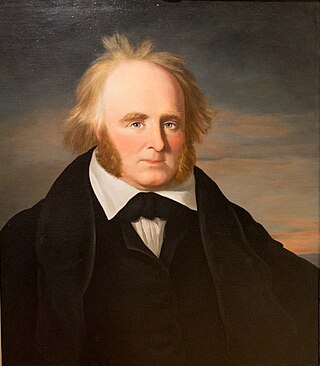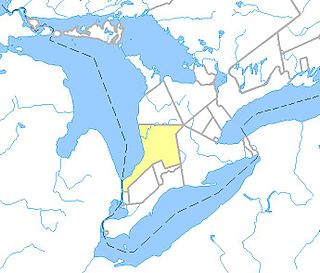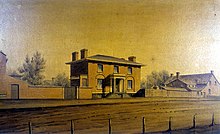
The Province of Upper Canada was a part of British Canada established in 1791 by the Kingdom of Great Britain, to govern the central third of the lands in British North America, formerly part of the Province of Quebec since 1763. Upper Canada included all of modern-day Southern Ontario and all those areas of Northern Ontario in the Pays d'en Haut which had formed part of New France, essentially the watersheds of the Ottawa River or Lakes Huron and Superior, excluding any lands within the watershed of Hudson Bay. The "upper" prefix in the name reflects its geographic position along the Great Lakes, mostly above the headwaters of the Saint Lawrence River, contrasted with Lower Canada to the northeast.

The Family Compact was a small closed group of men who exercised most of the political, economic and judicial power in Upper Canada from the 1810s to the 1840s. It was the Upper Canadian equivalent of the Château Clique in Lower Canada. It was noted for its conservatism and opposition to democracy.

John Galt was a Scottish novelist, entrepreneur, and political and social commentator. Galt has been called the first political novelist in the English language, due to being the first novelist to deal with issues of the Industrial Revolution.
Anthony Van Egmond was purportedly a Dutch Napoleonic War veteran. He became one of the first settlers and business people in the Huron Tract in present-day southwestern Ontario Canada. Van Egmond became an early contractor employed by the Canada Company to construct the original 74-kilometre (46 mi) road into the new settlement, allowing the entry of settlers for the purchase of company lands and further economic development. He eventually became a supporter of William Lyon Mackenzie and led a force of armed rebels in their unsuccessful skirmish at Montgomery's Tavern near Toronto on 7 December 1837, during the Upper Canada Rebellion.

Goderich is a town in the Canadian province of Ontario and is the county seat of Huron County. The town was founded by John Galt and William "Tiger" Dunlop of the Canada Company in 1827. First laid out in 1828, the town is named after Frederick John Robinson, 1st Viscount Goderich, who was prime minister of the United Kingdom at the time. It was incorporated as a town in 1850.
William Allan, JP, was a Scottish Canadian banker, businessman and politician.

The office of Commander-in-Chief, North America was a military position of the British Army. Established in 1755 in the early years of the Seven Years' War, holders of the post were generally responsible for land-based military personnel and activities in and around those parts of North America that Great Britain either controlled or contested. The post continued to exist until 1775, when Lieutenant-General Thomas Gage, the last holder of the post, was replaced early in the American War of Independence. The post's responsibilities were then divided: Major-General William Howe became Commander-in-Chief, America, responsible for British troops from West Florida to Newfoundland, and General Guy Carleton became Commander-in-Chief, Quebec, responsible for the defence of the Province of Quebec.

The Legislative Council of Upper Canada was the upper house governing the province of Upper Canada. Modelled after the British House of Lords, it was created by the Constitutional Act of 1791. It was specified that the council should consist of at least seven members. Members were appointed for life but could be dropped for non-attendance. The first nine members of the council were appointed on 12 July 1792. The speaker was usually the Chief Justice of the Court of King's Bench. The Legislative Council was dissolved on 10 February 1841 when Upper and Lower Canada were united into the Province of Canada. Some members were reappointed to the Legislative Council of the united Province.
Robert Graham Dunlop was a British naval officer and political figure in Upper Canada.
James McGill Strachan was a lawyer, business and political figure in Canada West, in the Province of Canada.
Joseph Gould was a farmer, businessman and political figure in Ontario, Canada.

William Dunlop also known as Tiger Dunlop, was an army officer, surgeon, Canada Company official, author, justice of the peace, militia officer, politician, and office holder. He is notable for his contributions to the War of 1812 in Canada and his work in the Canada Company, helping to develop and populate a large part of Southern Ontario. He was later elected as a Member of Parliament for the Huron riding in the 1st Parliament of the Province of Canada, Canada West.
Nathaniel Hughson was a farmer and hotel owner, a Loyalist who moved to Canada following the American Revolution, and one of the city founders of Hamilton, Ontario. Married to Rebecca Land who was the daughter of Robert Land and Phoebe Scott, both United Empire Loyalists.
Charles Albert Berczy was the son of pioneer William Berczy, later as businessman and civic official in Toronto.

The Huron Tract Purchase also known as the Huron Block, registered as Crown Treaty Number 29, is a large area of land in southwestern Ontario bordering on Lake Huron to the west and Lake Erie to the east. The area spans the counties of Huron, Perth, Middlesex and present day Lambton County, Ontario in the province of Ontario.

Frederick Widder (1801–1865) was a Canada Company commissioner and son of a Canada Company London director, with family connections to royalty and Anglican figures of influence. His moderate approach and financial innovations for the Canada Company gave him good standing with the pioneers of the Huron Tract and the reformers of Upper Canada. His administrative talents and hard work allowed him to advance past Thomas Mercer Jones and take the lead in the Canada Company.
James Andrews Miller, was a lawyer, judge and political figure in Manitoba. He represented Rat Portage from 1883 to 1886 in the Legislative Assembly of Manitoba as a Conservative. His name also appears as James Andrew Miller in some sources.

Formally known as "His Majesty's Council of Nova Scotia", the Nova Scotia Council (1720–1838) was the original British administrative, legislative and judicial body in Nova Scotia. The Nova Scotia Council was also known as the Annapolis Council and the Halifax Council. After 1749, when the judicial courts were established, the Nova Scotia Council was limited to administrative and legislative powers.
The British American Land Company (BALC) was a company formed in 1832 for the purpose of purchasing land and encouraging British immigration to Lower Canada. It was founded and promoted by John Galt, Edward Ellice and others to acquire and manage the development of almost 1,100,000 acres of Crown land and other lands in the Eastern Townships of Lower Canada, in order to encourage the immigration of British subjects to the region.
Bryan Finucane was an Irish-born lawyer who served as Chief Justice of Nova Scotia from 1778 to 1785.


















